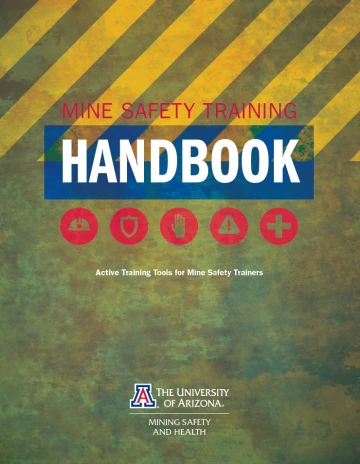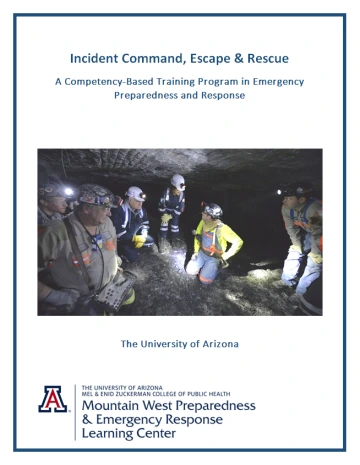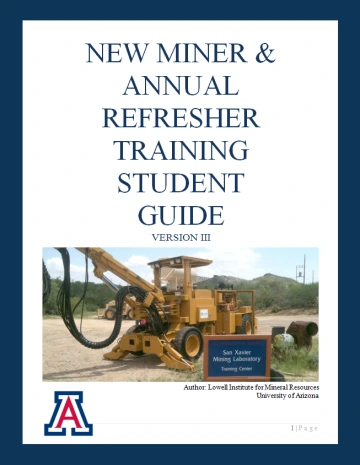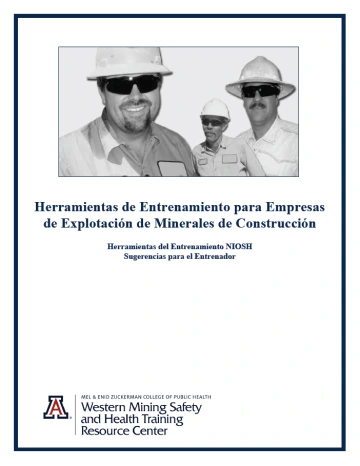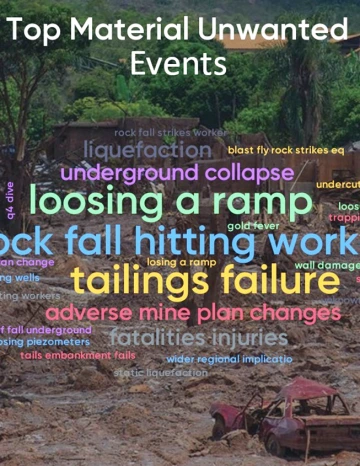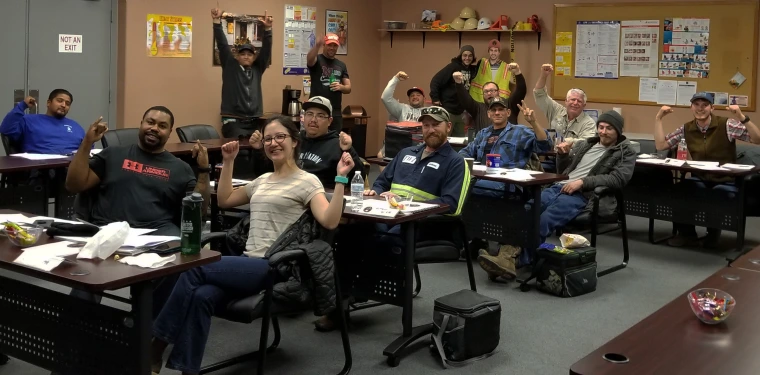
The Western Mining Safety and Health Training Resource Center has developed over 950 pages of handbooks and guides to increase training capabilities in mining safety and health. These resources integrate the collective knowledge of experts from numerous allied disciplines, including education, information, mining, public health, safety, and social sciences. Our guides and handbooks are useful to a broad audience of mining industry professionals, including front line workers, trainers, instructional designers, and supervisors.
This page provides access to the following resources:
- Mine Safety Active Learning Handbook
- Incident Command, Escape & Recsue Guide
- New Miner & Annual Refresher Guides
- Part 46 Toolbox Training (Spanish)
- Sharing Critical Controls Database
Many of our guides and handbooks are also available on print media at no cost to our training partners. Courses and workshops are offered covering most of these training resources. For additional information, please contact us.
Active Learning Handbook
The active learning handbook provides activities to improve learners' motivation, group dynamics, and transfer of safety knowledge to the mine site. The handbook places an emphasis on problem-based learning, compelling students to think their way through solutions while considering alternatives and consequences. The handbook also includes a variety of exercise templates covering the gamut of active learning techniques, such as fishbowls, knowledge hunts, puzzles, role play, and serious games. Many ready-to-use activities are included for use in mandated training courses. Active learning in large group situations is also discussed.
This colorful, 124 page handbook was developed for trainers and instructional designers in part with funding from the Alpha Foundation. It represents a collaborative effort of the University of Arizona's College of Public Health, Lowell Institute for Mineral Resources, and the College of Education. Hard copies are available to our industry partners. The Center also offers a complete train-the-trainer workshop to help you integrate this resource into your curriculum.
Quick Facts: Mine Safety Active Learning Handbook
| Media Type | Training Guidebook |
| Primary Authors | Aly Waibel, Eric Lutz, Michelle Lutz |
| Audience | Trainers, Instructional Designers |
| Training Topics | Active Learning, Group Facilitation, Instructional Design, Activity Templates |
| Primary Sectors | All Sectors |
| Activity Time | Variable |
| Requirements | None |
| Train-the-Trainer? | Available (Recommended) |
| Customizable? | Yes |
| Downloads | Mine Safety Active Learning Handbook, 124 pages (PDF) |
Incident Command, Escape & Rescue
Comprehensive, mine-specific emergency preparedness and response systems are critical to effective rescue and recovery operations. This guide applies best practices from the Incident Command System (ICS) approach to training in mine emergency preparedness and response. ICS is a standard methodology used by fire departments, search and rescue organizations, and other government agencies nation-wide. Our guide focuses on capacities to improve self-escape and provides an overview of key social and behavioral responses to high stress situations. An Emergency Preparedness and Response Competency Model was developed in parallel work and serves as a basis for the learning objectives of this guide.
This 87-page resource is suitable for trainers and instructional designers who are developing training for emergency response (e.g. mine rescue) as well as supervisors looking to identify gaps in response plans and improve organizational resiliency. Funding for this initiative was provided in part by MSHA through the Brookwood-Sago Mine Safety Grants Program.
Quick Facts: Incident Command, Escape & Rescue Guide
| Media Type | Training Guidebook |
| Primary Authors | Brenda Granillo, Staci Martin |
| Audience | Trainers, Learners (Incident Commanders, Mine Rescue, Supervisors) |
| Training Topics | Emergency Preparedness, Emergency Response, Self-Rescue, Crisis Management |
| Primary Sectors | Coal (Underground), Metal / Non-Metal (Underground) |
| Activity Time | 6-8 Hour Workshop |
| Requirements | None |
| Train-the-Trainer? | Available |
| Customizable? | No |
| Downloads | Incident Command, Escape & Rescue Guide, 125 pages (PDF), Storyboarding Exercise Design Activity, 7 pages (PDF), HSEEP-Compliant Escape Drill Template, 6 pages (PDF), Pre-Post Competency Self-Assessment, 8 pages (PDF) |
New Miner & Annual Refresher Guides
This comprehensive program guide addresses all required topics for MSHA 30 CFR Part 48 New Miner and Annual Refresher training. It provides a standardized framework for instructional design in mine safety and health, with a focus on active-learning to support or supplant lecture-based presentation. The content is conveniently arranged into modules around the 30 CFR Part 48 required topics, allowing trainers to select materials based on their organization's training needs. Many templates are included, providing ready-to-use activities for the trainer. The guides also provide knowledge checks and quizzes for assessment and group discussion.
The New Miner and Annual Refresher program guides include a student handbook (171 pages) and in-depth facilitator guide (466 pages) containing additional presentation and instructional design materials. These resources were developed by the Lowell Institute for Mineral Resources n part with funding from the Alpha Foundation. Hard copies are available to our industry partners. The Center offers a train-the-trainer workshop to help you integrate these program guides into your curriculum.
Quick Facts: New Miner & Annual Refresher Guides
| Media Type | Training Guidebooks (2) |
| Primary Authors | Laurie Wilson, Michelle Lutz, Mary Poulton |
| Audience | Trainers, Instructional Designers, Learners (All Personnel requiring MSHA Certification) |
| Training Topics | 30 CFR Part 48 (Surface / Underground): MSHA New Miner - All Topics, MSHA Annual Refresher - All Topics |
| Primary Sectors | Coal (Surface / Underground), Metal / Non-Metal (Surface / Underground) |
| Activity Time | 8 Hours, Annual Refresher, 24 Hours, New Miner, 40 Hours, New Miner |
| Requirements | None |
| Train-the-Trainer? | Available (Recommended) |
| Customizable? | Yes |
| Downloads | New Miner & Annual Refresher: Trainer Guide, 466 pages (PDF), New Miner & Annual Refresher: Student Guide, 171 pages (PDF) |
Part 46 Toolbox Training (Spanish)
The Center has developed a comprehensive Spanish translation of the National Institute for Occupational Safety and Health (NIOSH) Toolbox Training for Construction Aggregate Miners. The guide contains 52 modules that are "designed to stimulate safety discussions among your employees. Each module is intended to be completed in roughly 10 or 15 minutes, so a Toolbox Training session can be conducted once a week for the entire year. Each session can count toward your employee's 8-hour annual MSHA refresher training."[1] Modules are divided into stages that include identifying hazards, discussing causes, identifying best practices, and reviewing relevant near misses. Additional information may be found on the NIOSH toolbox training website.
This resource has been vetted by mining industry professionals who are fluent Spanish speakers to verify the accuracy of the translation. Our Spanish toolbox training guide has been tested extensively by industry partners in their 30 CFR Part 46 annual refresher courses.
Quick Facts: Toolbox Training for Construction Aggregate Miners (Spanish)
| Media Type | Training Guidebook |
| Primary Authors | NIOSH (Source materials), WMSHTRC (Spanish translation) |
| Audience | Trainers, Instructional Designers, Learners (All Personnel requiring MSHA Certification) |
| Training Topics | 30 CFR Part 46 (Construction Aggregates): MSHA Annual Refresher (Numerous Topics) |
| Primary Sectors | Construction Aggregates |
| Activity Time | Variable |
| Requirements | Spanish Proficiency |
| Train-the-Trainer? | Available |
| Customizable? | No |
| Downloads | Part 46 Toolbox Training in Spanish, 56 pages (PDF), Part 46 Toolbox Training in English, NIOSH source materials (PDF) |
Sharing Critical Controls
Although the mining industry understands the value of sharing lessons in safety through data collection and reporting on incidents and fatalities, there are few avenues to share strategies on prevention and mitigation. To address this problem, the Center is working to identify and share the critical controls that companies are using to prevent or mitigate accidents and injuries. Through a series of workshops and meetings, we are soliciting critical controls for inclusion into a standardized database that can be shared across the mining industry. The critical controls database currently focuses on geotechnical controls which are associated with material unwanted events (MUEs).
The critical controls database is being developed in collaboration with the Geotechnical Center for Excellence at the Lowell Institute for Mineral Resources. This safety-focused geotechnical resource will be useful for trainers seeking new annual refresher content, as well as supervisors wishing to evaluate or improve their own geotechnical controls for MUEs. Further information on this initiative may be found in our white paper (PDF).[2]
Quick Facts: Critical Controls Database
| Media Type | Excel Spreadsheet + White Paper |
| Primary Authors | Brad Ross, Chad Williams, Jeff Burgess, Brenda Granillo |
| Audience | Trainers, Supervisors, Mine Engineers (Geotechnical) |
| Training Topics | Critical Controls, Material Unwanted Events, Mitigation, Prevention |
| Primary Sectors | All Sectors |
| Activity Time | Variable |
| Requirements | Microsoft Excel |
| Train-the-Trainer? | No |
| Customizable? | Yes |
| Downloads | Critical Controls Database, 285 KB (Excel File), Sharing Critical Controls, White Paper, 5 pages (PDF) Note: Refer to Geotechnical Center for Excellence for latest dataset. |
Further Reading
- National Institute for Occupational Safety and Health (NIOSH), Centers for Disease Control and Prevention (CDC), Dept. of Health and Human Services, U.S. (2004). "Mining Product: Toolbox Training for Construction Aggregate Miners." Publication 2004-162. Available at NIOSH / CDC
- Ross, B., Williams, C., Burgess, J., Granillo, B. (2019). “Sharing Critical Controls.” SME Annual Conference and Expo, Society for Mining, Metallurgy, & Exploration. Denver, CO.


